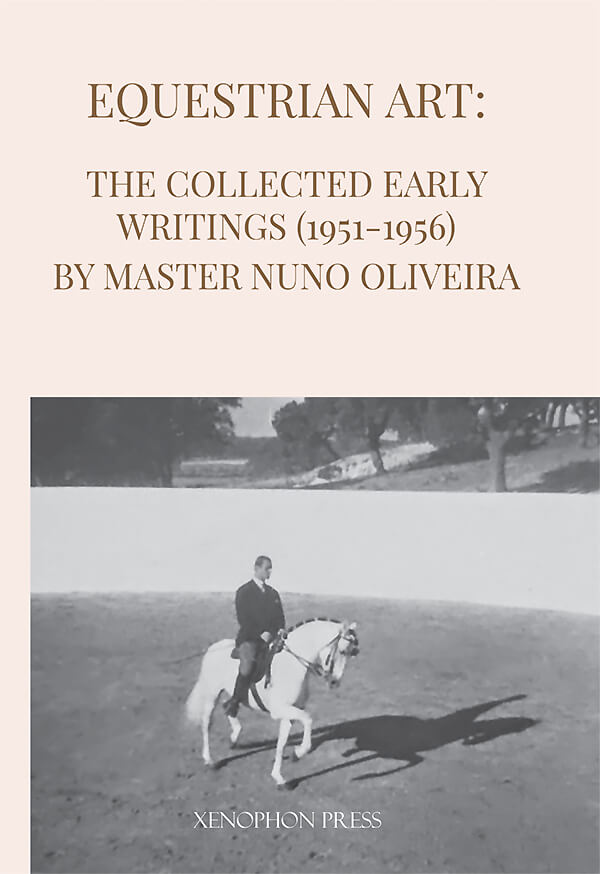
I was lucky enough to ride in a number of Nuno Oliveira’s clinics in the 1980’s. They were occasions of great drama, as several of the self-anointed Great Ladies of the dressage scene battled for Nuno’s attention, but if you cut out the clatter, and listened hard, there was so much to learn. Just how much, I don’t think I appreciated then, reading through two splendid publications from Xenophon press, Equestrian Art: The Collected Early Writings (1951 – 1956) by Master Nuno Oliveira, and its companion The Collected Later Works, I realise just how much of the subtly and depth of the great man’s thoughts I had missed. These books are jam-packed with insights and pearls of wisdom, it was hard not to keep marking points to discuss for this review.
Nuno is best known for his high school work, let’s stand that on its head, and start with his advice for breaking in the young horse:
“From the very first lesson, one should desire the colt to work as calmly as possible, with confidence and not in fear. It is a great error to give the first lesson using the snaffle bridle. The defenses that appear in this case are almost always motivated by the fear that the colt feels with the steel in his mouth.”
“There is nothing better than a simple stable halter with some reins attached to the sides.”
Just a few pages on, we are in the rarified realms of In-hand work, once again, the advice is eminently sensible:
“What is necessary when working with the whip, is that you do not contract him (make him tense) with the touch of the whip, making him shrink back and putting him in a position that many people classify as rassembler, but this is not what it is; the horse looks more like a cat when it stretches, making his back convex.”
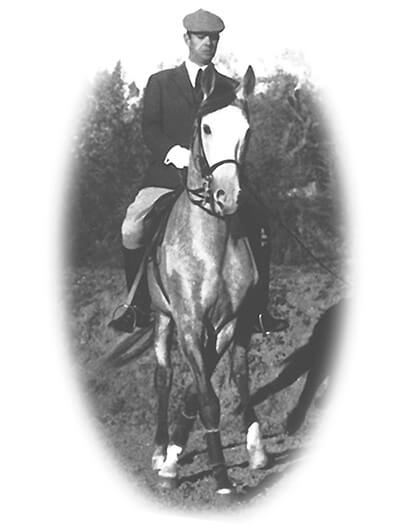
The book is also enriched by a wonderful collection of photos of Nuno working his horse. This is of
Zarco, Portuguese stallion in half-pass at the walk to the left, after ten months training.
Photo by Pedro Villalva from Hauté Ecole
It was not for nothing that Nuno worked to a soundtrack of opera, his approach was one that emphasized emotion:
“Today I will not go into the subject of training, but rather I will tell you the story of two or three horses that I have fallen in love with and that I will never forget! Those who are close to me, my most advanced students, will laugh, because they are used to hearing me talk about almost all the horses that I have ridden (and they are not few!) and I have fallen in love with all of them, always finding them to be extraordinary. This is not lack of sincerity, but passion for the formidable art of riding. But let’s get to the stories…”
And for those gentle reader you will have to purchase the book.
Nuno was one of the great masters of the flying change, it’s wise to listen to him on the subject: “To understand and execute the flying changes well, it is necessary to have studied thoroughly and practiced the departures into canter from the walk and the halt. A flying change is a departure into canter made from the canter itself.”
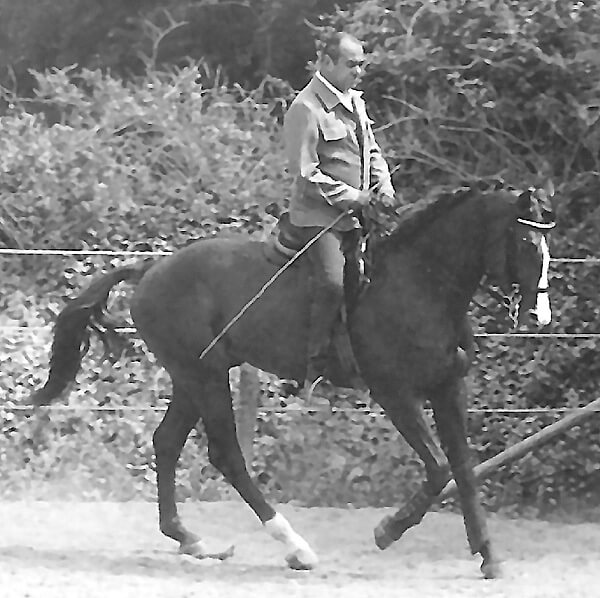
Nuno Oliveira nearing the end of his career, helps a young Russian stallion find balance at the canter. Courtesy of Olms Verlag
The gems keep flowing: “What is worthwhile? To take more time, following rational and gentle processes and methods, in order to solve a problem, which at first sight, seems to be settled with the use of the spur or the rein, with more or less force. It is worth it, yes, to ‘put on your slippers’ as advised by Baucher, and try to ride all horses, without exception, using either the reins or the legs as gently as possible and with the least effort.”
Another, “The role of the aids in the handling of a well-trained horse can be summarized in the following formula: The rider’s legs give the horse the impulsion, the hands regulate, via the reins, the way to expend that impulsion… The old master (Victor) Franconi, when visited one day by a royal prince who asked him to teach his son (a rider of great ease) to coordinate the action of the legs and the hand, replied that he had been riding for 50 years and that he did not always get good accordance of the aids.”
“How often do horses respond badly to the rider’s aids, because these aids are not in accordance, contradicting each other. The hand receives what the legs do, regulates, but never contradicts.”
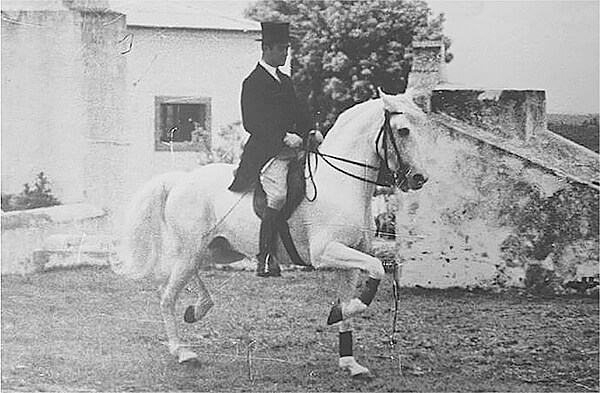
Garoto demonstrates maximum impulsion in passage under Nuno Oliveira in the Portuguese countryside
1950 Oliveira Archives
I must confess that I never imagined Nuno pushing metal in a gym or out for a jog but he was still aware that the rider had a responsibility to prepare his or her body adequately for the task of riding. Talking of riding in Hitler’s Germany:
“Shortly before there had been an Olympics in which the German riders had performed badly in every discipline. Hitler called the person in charge of selecting the German teams to him and told him that by the next Olympics (1936) he had to prepare the German riders so that they would be among the best. This gentleman began to observe very carefully the riders he judged likely to compete and came to the conclusion that all or almost all sinned by excessive rigidity on horseback… The result was that in 1936 the Germans were ranked first in the equestrian events.”
“This gymnastics is indispensable in the education of a rider who wants to be worthy of the name, riding well, instead of being carried in any way on the back of this admirable quadruped.”
Does the next paragraph remind you of some of the sights you might observe in today’s competition arena?
“In the piaffe, when the horse leans over his forehand, putting his forelegs rather far back, under his mass, it is because he is behind the bit and has no real impulsion.”
“In these out-of-balance piaffes (with the forelegs set back on the ground behind the point of the chest) there is always a lack of cadence, lack of rhythm and suspension, and ensuing lateral deviations.”
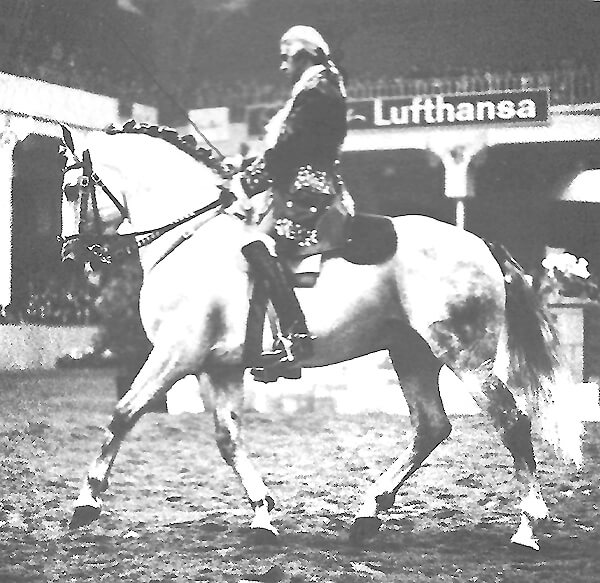
Nuno Oliveira shows Euclides at the International Horse Show of Geneva.
1967 Photo Courtesy of Olms Verlag
Here’s another gem:
“You often hear that so-and-so is an extraordinary rider because he has very good hands. Rarely do you hear that someone is a splendid rider because he knows how to act with his legs very well. Both are of equal importance if you want to be worthy of being called a good rider… The rider’s legs should be connected to the horse, but completely relaxed and lowered so that whenever they need to act or intervene, they act or intervene in a supple way for the horse to respond with suppleness, and not in a rigid and hard manner to which the horse invariably responds with rigidity, hardness or rejection.”
Poor Nuno, his reputation suffered because he attracted some appalling riders, who rode in a parody of the great man’s style and teachings, loudly proclaiming as they did so, that this was what they had learned from Nuno. Luckily we have these two new books to make us aware once again of how much knowledge and insight Nuno Oliveira had to offer. I will review the second volume that contains his later writings in another article, but for now, let’s finish, as volume one as Nuno does, with these words:
“The horse is man’s noblest conquest. Academic and artistic equitation is a school in virtue for the horseman. Patience, firmness, humility and common sense are indispensable virtues for whoever desires to attain a high level of dressage in his horse.”
“One of the beauties of art resides in the technically perfect execution and the relaxed ease of the artist. In order to obtain the greatest brilliance in the execution of any exercise it is necessary that the horse works with the lightest aids.”
We should be grateful to Richard Williams of Xenophon Press, who has kept alive so many of the great equestrian books. On this occasion he has published Nuno’s thoughts in two paperback volumes, but they are also available in collector’s hard cover editions. Visit the Xenophon website and marvel at what is to be found… https://xenophonpress.com
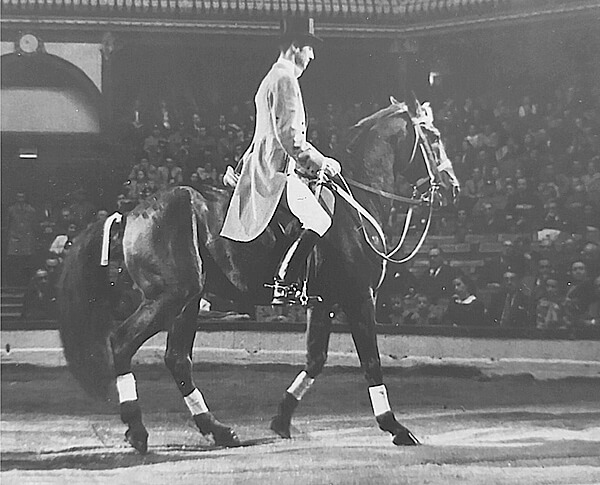
Diestro demonstrates serpentines in rein back at the Coliseu dos Recreios
1952 Oliveira Archives

Great thoughts from the Master Nuno Oliveria. Thank you for sharing .
Nuno was a legend. I have watched him give lessons here in Australia, also watched him ride numerous problem horses, that were never a problem to Nuno. He never appeared to move so much as a finger when he rode. At the time I was mesmerised by his riding.
That’s for sharing this
I was privileged to spend 3 months at Quinta do Brejo having lessons with “the Masters” Nuno Oliveira. Plus watching him ride his Russian horse “Bunker”.
Every afternoon at precisely 2pm I witnessed Mestre Nuno Oliveira riding Bunker a vision of pure harmony and elegance that still lives in my memory.
After studying intensely under his protege, and applying this work to everyday horse problems, I have saved many horses lives.
I wish I could have met him, but I did not start my immersive journey into classical work until the early 90’s.
I feel very blessed to have been able to utilize his teachings for my horses and students. Also, using it to rehabilitate many damaged horses.
I devoted my life to preserving the Art of Horsemanship the day I felt the difference back in Buffalo, NY under one of his students.
She opened a new door for me in the horse world!
Many thanks to all this who continue to do their best to keep it alive!
I do it FOR THE LOVE OF ALL HORSES!
Brilliant ideas and totally relevant to the horse welfare issues we are all talking about today. We would be wise to review the old master Nuno’s methods and compare to our modern training scale.